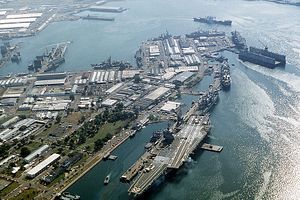U.S. President Barack Obama returns from Asia with a major deliverable on the security side of the “pivot to Asia”: the Enhanced Defense Cooperation Agreement with the Philippines, signed Monday. Under the agreement, the U.S. military will enjoy greater access to bases across the Philippines archipelago for a 10-year term. The agreement does not amount to a formal basing agreement nor does it imply that U.S. troops or other assets will be stationed in the Philippines permanently. The constitution of the Philippines forbids the country from hosting a permanent U.S. military presence or base.
The agreement was signed by U.S. Ambassador to the Philippines Philip Goldberg and Philippine Defense Secretary Voltaire Gazmin. The signing was timed with President Obama’s arrival in Manila— the last leg of his four-nation Asia tour, following visits to Japan, South Korea, and Malaysia. According to the Associated Press, U.S. troops would be deployed “on temporary and rotational basis” to the Philippines. Goldberg noted that the agreement will “promote peace and security in the region,” particularly by allowing U.S. and Philippine forces to respond quickly to disasters in the region. For example, last year’s deadly Typhoon Haiyan in the Philippines resulted in the U.S. Navy deploying several assets to assist the Philippines. With this new agreement, the Navy’s response time would be increased.
In general, the agreement will allow the U.S. Navy greater operational flexibility in the South China Sea — a sea that is slowly beginning to crowd with a profusion of ships and bases as protracted territorial disputes continue to cause concern across the region. The deal was motivated by the Philippines’ own concerns about possible Chinese aggression concerning the disputed Scarborough Shoal and the Second Thomas Shoal. In China, the deal will be seen as another brazen attempt at containment by the United States and the Philippines.
For the moment, the U.S. and the Philippines have yet to make public the specific number of U.S. troops that will be temporarily deployed in the Philippines as a result of the agreement. This number is likely to depend on planned joint activities between the two militaries. Further, while the deal will not require the U.S. military to pay rent, Navy Times notes that the Philippines “will own buildings and infrastructure to be built or improved by the Americans and reap economic gains from the U.S. presence.”
According to the Wall Street Journal‘s Southeast Asia Real Time blog, the U.S. will gain access to Subic Bay, Cubi Point, Clark Air Base, Oyster Bay, Brooke’s Point, and the Batanes Islands. The Batanes Islands, in particular, are an interesting vantage point for the U.S. Navy, as they are just over 100 miles from the southern tip of Taiwan (about the same distance from Taiwan as Japan’s westernmost Island, Yonaguni, where the Japanese military recently deployed 100 troops and a radar installation). Access to Batanes will prove useful should a crisis emerge in the Taiwan Strait or even the Diaoyu/Senkaku Islands.
In 1991, Filipino legislators voted to evict the United States military from Subic Bay and Clark Air Base. In 1999, following provocative actions by China, the Philippines allowed temporary passage and visitation to U.S. ships and other military assets. In the past decade, U.S. forces have been assisting the Philippines military in counterterrorism preparation as the country has struggled with separatist Muslim militants.

































